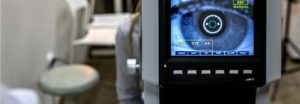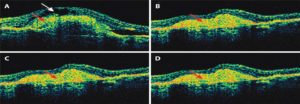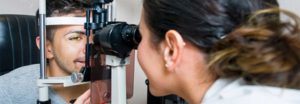Our Services Include:
- General Eye Examination
- Optical Coherence Tomography
- Corneal Topography
- Computerized Tonometery
- Visual Field Analysis
- Subjective Refraction
- Slit-lamp Examination
- Ophthalmoscopy
- Contact Lens Fitting
- Orthokeratology
- Prescribing Spectacles
- Pediatric and Geriatric Screening
- Myopia Control for Children
GENERAL EYE EXAMINATION

Everyone needs regular eye exams to detect and prevent vision problems. Singapore has seen one of the highest prevalence of myopia in the world; and especially troubling are the myopia cases that we see that involve young children.
Regular eye exams are also critical for detecting:
- Age-Related Macular Degeneration (AMD)
- Glaucoma
- Cataract
- Diabetic Retinopathy
We advise that children need to have their vision checked at 6 months and come for regular vision checkups at least every two years. Adults should see an optometrist at least once every two years, with more frequent exams if you have a health condition such as high blood pressure or diabetes.
People working with visually exhaustive activities – such as looking into the computer screen for a long length of time, or out in the hot sun – should consult us about ways to protect and maintain your healthy vision.
OPTICAL COHERENCE TOMOGRAPHY

Optical Coherence Tomography (OCT) is an established medical imagery method that uses light waves to take cross-section pictures of your retina – the sensitive tissue lining the back of your eyes.
It is safe and non-invasive. The measurements are used for early detection and diagnosis of retinal diseases and conditions, including age-related macular degeneration and eye disease caused by diabetes.
Corneal Topography
Corneal Topography is a non-invasive medical imaging technique to map the surface curve of the cornea – the front surface of the eyes, allowing the optometrist to see a detailed description of the shape and power of the cornea.
As the cornea is responsible for most of the eye’s refractive power, its topography is a highly important aid for the optometrist to determine the corneal health and vision quality. The process takes seconds and is completely painless.
It will aid the optometrist in:
- Prescribing the best fitting contact lenses
- Diagnosis, monitoring and treatment of visual conditions.
COMPUTERIZED TONOMETRY
Computerized Tonometry is a non-invasive method of measuring eye pressure and ensures the pressure within the eyeball is within the normal range.
Abnormal readings will indicate the need for further diagnostic testing to rule out glaucoma. Glaucoma is significant because, if left untreated, it can eventually lead to vision loss.
VISUAL FIELD ANALYSIS
Visual Field Analysis is an eye examination that can detect abnormal loss of peripheral and central vision, or the loss of sensitivity in any area on the back of the eye.
Dysfunction in peripheral or central vision can be caused by a wide range of medical conditions, and will require further testing to determine the reason for vision problems or treatment if needed.
SUBJECTIVE REFRACTION
Subjective Refraction is used to determine, by the use of a combination of lenses, your best corrected visual acuity (BCVA).
It is a clinical examination used by our optometrists to correct refractive error, either using eyeglasses or contact lenses. The results are crucial to determine your correct prescription, and ensure that you will receive the best vision possible.
SLIT LAMP EXAM

The slit lamp exam uses an instrument that provides a magnified, three-dimensional (3-D) view of the different parts of the eye. During the exam, the front parts of the eye, including the cornea, the lens, the colored part (iris), and the front section of the gel-like fluid (vitreous gel) that fills the large space in the middle of the eye may be examined clearly.
A slit lamp exam may be performed:
- Detect disorders in the structures in the front of the eye, such as infection or injury to the cornea, cataracts, conjunctivitis, or iritis.
- Detect and monitor glaucoma or macular degeneration with aid of additional lenses.
- Check for a foreign body, such as fragments, on or in the eye.
- Detect eye problems that may be caused by other diseases, such as diabetes or rheumatoid arthritis. Routine slit lamp exams are important to detect eye problems at an early stage and to guide treatment if eye problems develop.
- To monitor complications such as bleeding after an eye injury.
- To monitor complications such as cataract formation that canoccur due to age and UV exposure
OPHTHALMOSCOPY
Ophthalmoscopy (funduscopy or fundoscopy) is a simple and non- invasive test that allows a health professional to see inside the fundus of the eye and other structures using an ophtalmoscope.
It is part of a routine eye examination and helps to determine the health of your retina and vitereous humor.
OTHER SERVICES
We perform contact lens fitting, prescribing spectacle frames, pediatric and geriatric eye screening, and myopia control for children.